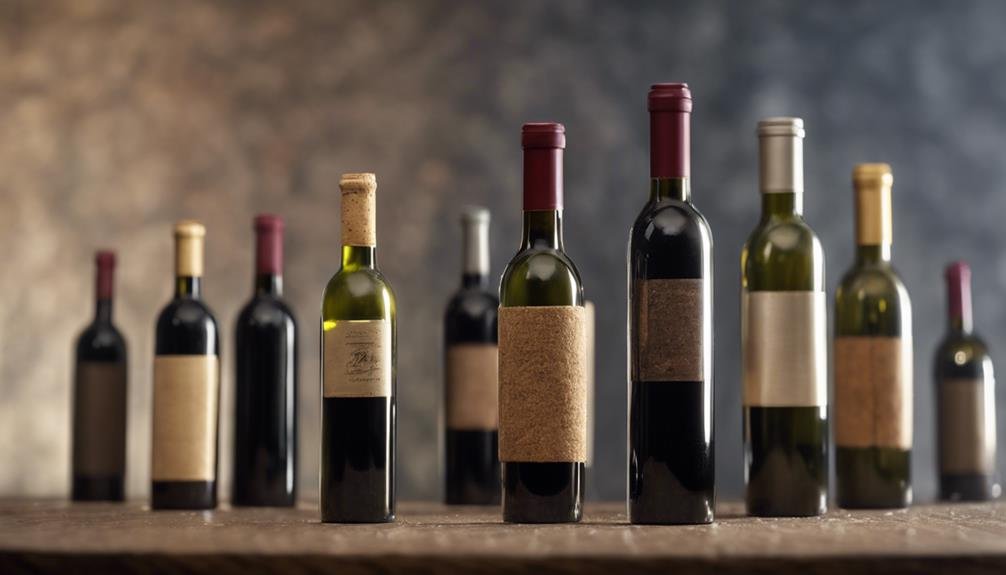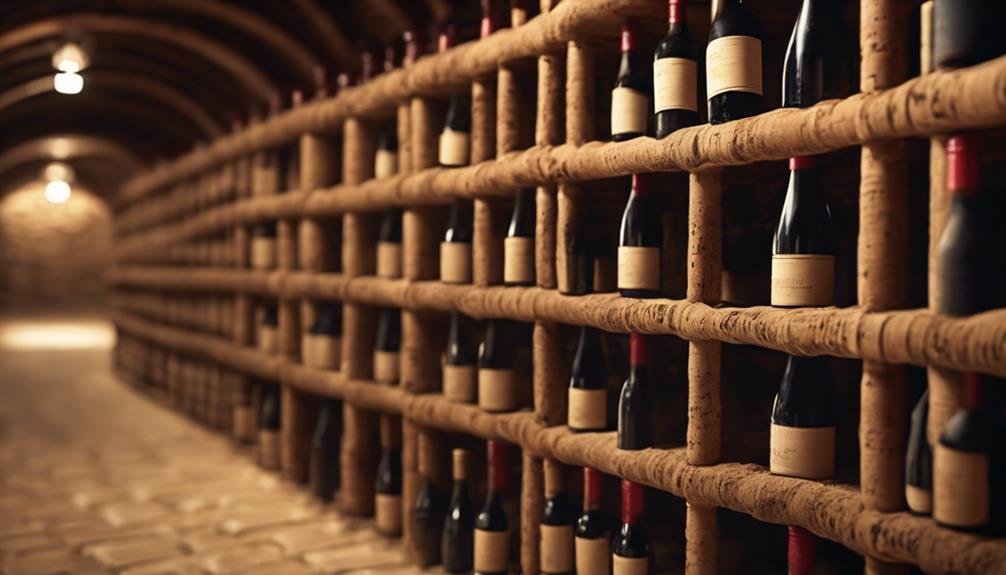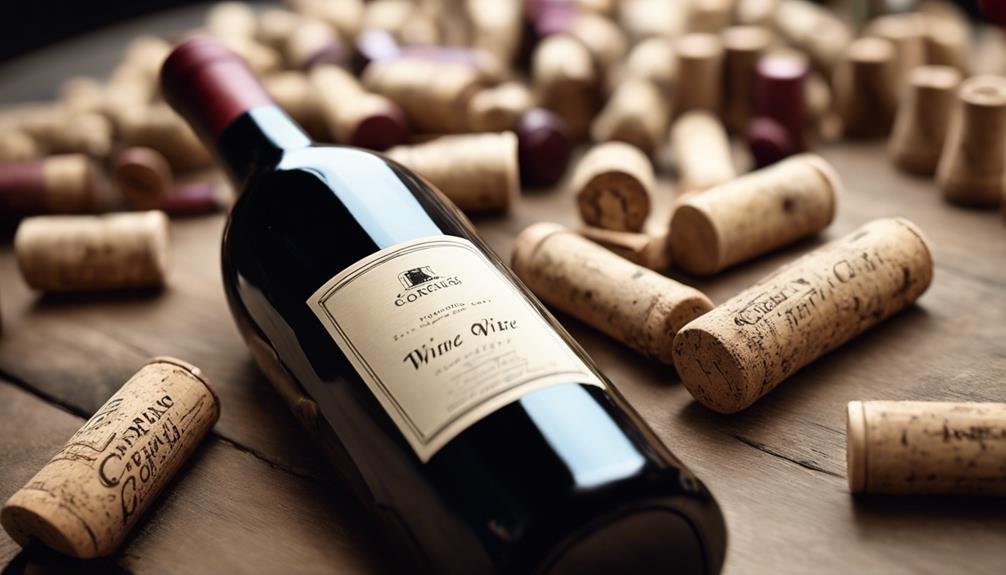Oxygen exposure through closures, especially corks, profoundly impacts wine aging. Natural corks limit oxygen intake, shaping flavor development. Synthetic corks offer consistent oxygen release, altering aging potential. Screw caps control oxygen transmission, influencing flavor evolution. Varied liners in screw caps regulate oxygen intake, determining aging trajectory. Synthetic closures provide importance, while metal closures offer favorable oxygen rates. Understanding closure effects is essential for wine aging and flavor profiles. The choice of closure affects aging outcomes importantly, hinting at essential factors for best decision-making.
Aging and Oxygen Interaction
The interaction between aging and oxygen is a critical factor that influences the development and characteristics of wine over time. As wine ages, fruit acids within the liquid react with alcohol, leading to various changes in the composition.
The impact of oxygen on wine is profound, as controlled exposure can enhance flavors, while excessive oxygen can result in undesirable alterations. Oxidation, a process catalyzed by oxygen, plays a significant role in the transformation of wine, often yielding distinct changes in aroma and taste.
Understanding how oxygen affects wine is essential for winemakers to control the aging process effectively. By managing oxygen intake, winemakers can steer the wine towards desired characteristics and prevent unwanted outcomes such as oxidation-induced off-flavors.
Cork Types and Oxygen Influence
Different closures used in wine bottling have varying impacts on oxygen exposure and aging potential, with cork types playing an important role in influencing these factors. Natural cork, synthetic cork, and screw caps are the main options available for winemakers to seal their bottles. Here is how they affect oxygen exposure and aging potential:
- Natural cork: Allows minimal oxygen intake, influencing flavor development.
- Synthetic cork: Offers consistent oxygen transmission, impacting aging potential.
- Screw caps: Provide controlled oxygen transmission, affecting flavor evolution.
- Different liners: Control oxygen intake in screw caps, influencing the wine's aging trajectory.
Plastic and Metal Closure Options

Considering the advancements in wine closure technology, winemakers have various options when it comes to plastic and metal closures. Synthetic corks, typically made from polyethylene, offer consistency and no risk of tainting the wine. These closures allow controlled oxygen transmission, impacting the aging process.
On the other hand, screw caps, composed of a metal cap and liner, provide a different alternative. The liners in screw caps can be adjusted to control oxygen transmission, affecting how the wine ages.
When comparing these closure options, winemakers should consider factors like environmental impact and cost. Synthetic closures are often cheaper and more predictable, while metal closures offer different oxygen transmission rates based on the liner used.
Optimal Closure Selection Factors
Factors influencing the selection of the best wine closure include environmental impact, cost considerations, and desired aging outcomes. When selecting a closure, it is important to take into account factors such as oxygen transmission and closure consistency. Here are some key considerations:
- Oxygen Transmission: The amount of oxygen that the closure allows to interact with the wine can have a notable impact on its aging process and overall flavor profile.
- Closure Consistency: Ensuring that the closure provides a reliable seal is essential for maintaining the wine's integrity over time.
- Environmental Impact: Considering the sustainability and eco-friendliness of the closure material is important for environmentally conscious consumers.
- Cost Considerations: Balancing the cost of the closure with the desired aging outcomes is essential for wineries looking to optimize their aging process.
Long-Term Aging Considerations

In evaluating the suitability of closures for long-term aging, the impact of oxygen transmission and closure consistency on the wine's aging potential becomes essential. Cellar conditions play a significant role in determining how a wine ages over time. Oxygen exposure, controlled by the closure type, influences the wine's evolution, affecting its flavor profile and overall quality. Proper oxygen intake is important for the aging process to unfold harmoniously, ensuring that the wine develops desirable characteristics.
Frequently Asked Questions
How Does Oxygen Intake Impact the Aging Process of Wine?
Oxygen levels have a notable impact on wine aging by influencing fruit acids, oxidation, and preservation. Controlled oxygen intake allows desirable aging effects, while preventing oxidation. Understanding how sealing methods regulate oxygen exposure is essential for wine quality and longevity.
What Are the Differences Between Natural Cork, Synthetic Cork, and Screw Caps?
Natural cork, synthetic cork, and screw caps are wine closure options. Natural cork, used for centuries, can sometimes taint wine. Synthetic corks offer consistency and no taint. Screw caps, with varying liners, provide controlled oxygen transmission.
Do Synthetic Corks Affect the Taste of Wine Differently Than Natural Cork?
Synthetic corks, with consistent oxygen transmission, may slightly alter a wine's flavor profile compared to natural cork. While both closures can impact aging and aroma retention, natural cork remains favored for long-term aging due to its proven track record.
How Do Different Liners in Screw Caps Control Oxygen Transmission?
Different liners in screw caps control oxygen transmission by creating a controlled environment within the bottle. Specific liners regulate the amount of oxygen that enters, aiding in oxidation prevention. Understanding these mechanisms is essential for wine aging.
Why Is Natural Cork Considered the Safest Option for Long-Term Aging of Wine?
Natural cork is deemed the safest for long-term wine aging due to its unique benefits. It allows controlled oxygen transmission, aiding the aging process by promoting gradual maturation while preserving fruit acids. Cork's traditional use supports wine's evolution.
Conclusion
In the intricate domain of winemaking, the choice of closure holds the key to the aging potential of wines. From the traditional natural cork to modern synthetic options, each closure type shapes the wine's journey, influencing its development and ultimate profile.
The interaction between oxygen and wine, guided by the closure choice, sets the stage for a unique and evolving aging process. Just as a cork seals a bottle, it also seals the fate of the wine within, determining its aging trajectory.
